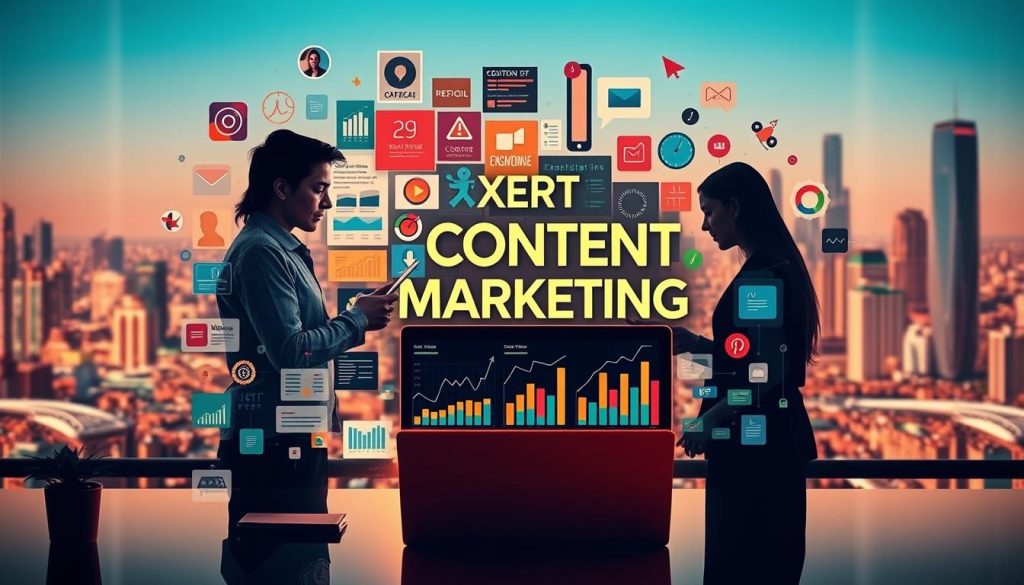Content marketing has revolutionized the way businesses connect with their audience. By developing and distributing relevant, useful content, companies convey their expertise and build trust with current and potential customers.
Today’s digital landscape demands more than just occasional blog posts. A sophisticated marketing strategy involves a multi-channel approach, including newsletters, white papers, social media, emails, and videos, all working together to drive real business results.
As content marketing continues to evolve, nearly half of global decision-makers are increasing their budgets in this area. We will explore the expert strategies behind successful content marketing and how they create a sustainable competitive advantage.
Key Takeaways
- Content marketing establishes and nurtures relationships with prospective and existing customers.
- A multi-channel content approach drives real business results.
- Global decision-makers are increasing their content marketing budgets.
- Expert strategies are crucial for successful content marketing.
- Content marketing creates a sustainable competitive advantage.
Understanding Content Marketing Fundamentals
To grasp the full potential of content marketing, it’s essential to understand its core fundamentals. Content marketing is a strategic approach focused on creating and distributing valuable, relevant, and consistent content to attract and retain a clearly defined audience — and, ultimately, to drive profitable customer action.
Definition and Core Concepts
At its core, content marketing revolves around three main activities: content creation, content distribution, and content engagement. Content creation involves producing high-quality, relevant content that addresses the needs or interests of your target audience. This could be in the form of blog posts, videos, whitepapers, or social media posts. The key is to focus on quality and relevance, ensuring that your content solves a problem, answers a question, or provides new insights.

The Three Key Elements of Content Marketing
The success of a content marketing strategy depends on the harmonious functioning of its three foundational elements: creation, distribution, and engagement.
- Content creation is the foundation, focusing on producing valuable content that resonates with your audience.
- Content distribution ensures that your content reaches your target audience through various channels, including social media, email newsletters, and third-party publications.
- Content engagement transforms passive content consumption into active relationships, fostering engagement through comments, shares, and other interactions.
| Element | Description | Importance |
|---|---|---|
| Content Creation | Producing high-quality, relevant content | High |
| Content Distribution | Sharing content across various channels | High |
| Content Engagement | Fostering interaction with the audience | High |
For a deeper dive into how content marketing can drive leads, visit this insightful article that explores the connection between content marketing and lead generation.
What Content Marketing Do for Businesses
Effective content marketing is crucial for businesses aiming to establish a strong market presence and foster customer loyalty. By leveraging content marketing, businesses can achieve a multitude of objectives that are critical to their growth and sustainability.
Building Brand Awareness and Authority
Content marketing plays a pivotal role in building brand awareness and establishing a company as a thought leader in its industry. By creating informative and engaging content, businesses can increase their visibility and credibility among their target audience. This, in turn, helps in establishing trust, which is a fundamental element in converting potential customers into loyal clients.
Generating Quality Leads and Conversions
A well-crafted content marketing strategy is designed to attract potential customers and guide them through the sales funnel. By providing value through relevant content, businesses can generate quality leads that are more likely to convert into sales. This approach not only drives revenue but also ensures a higher return on investment compared to traditional marketing methods.
Fostering Customer Relationships and Loyalty
Content marketing extends beyond customer acquisition; it is also a powerful tool for fostering customer relationships and loyalty. By delivering ongoing value through various types of content, businesses can strengthen their relationships with existing customers, encouraging repeat purchases and positive word-of-mouth. This is achieved through product education, community building, and creating emotional connections that transcend transactional relationships.
| Content Type | Purpose | Customer Benefit |
|---|---|---|
| Product Education | Informs customers about product usage and benefits | Enhanced customer satisfaction and reduced support queries |
| Community Building | Creates a platform for customers to interact and share experiences | Fosters loyalty and encourages brand advocacy |
| Emotional Connection | Establishes an emotional bond between the customer and the brand | Increased customer retention and loyalty |
The Content Marketing Ecosystem
Content marketing success depends on a balanced ecosystem that includes content creation, strategic distribution, and meaningful engagement. We will explore how these elements work together to drive business results.
Content Creation, Distribution, and Engagement
Content creation is the foundation of any content marketing strategy. It involves producing high-quality, relevant content that addresses the needs and concerns of the target audience. Distribution channels such as social media, email newsletters, and blogs play a crucial role in ensuring that the content reaches the intended audience.
Engagement is the final piece of the puzzle, where the audience interacts with the content, sharing their thoughts and feedback. Effective content marketing requires a balance between these three elements.
Aligning Content with the Buyer’s Journey
Aligning content with the buyer’s journey is crucial for maximizing its impact. The buyer’s journey consists of three primary stages: awareness, consideration, and decision. At each stage, different types of content are more effective.
| Stage | Content Type | Goal |
|---|---|---|
| Awareness | Educational content, how-to guides | Address pain points, answer questions |
| Consideration | Case studies, comparison guides | Evaluate solutions, position offerings |
| Decision | Testimonials, validation content | Provide confidence for final selection |
By mapping content to the buyer’s journey, businesses can create a more efficient sales funnel, delivering the right information at the right time.

Essential Content Marketing Formats
Content marketing success hinges on selecting the right formats for your audience. In today’s diverse digital landscape, businesses must leverage multiple content formats to effectively engage their target audience and achieve their marketing goals.
Blog Posts and Articles
Blog posts and articles remain cornerstone content marketing formats. They offer in-depth information, establish authority, and drive traffic through SEO. Well-crafted blog content can address specific pain points, providing value to your audience.
Video Content
Video content has become increasingly popular, offering a dynamic way to convey complex information in an engaging manner. From explainer videos to product demos, video content can significantly boost engagement and conversion rates.
Social Media Content
Social media platforms provide a vast array of content opportunities, from short-form videos to detailed posts. Tailoring content to each platform’s unique audience and format is crucial for maximizing audience reach and interaction.
Email Marketing
Email marketing remains a powerful tool for nurturing leads and fostering customer relationships. Personalized and targeted email campaigns can drive conversions and enhance brand loyalty.
Podcasts and Audio Content
Podcasting is a rapidly growing medium, with nearly 505 million worldwide listeners projected by 2024. It offers a convenient way to consume content on the go, helping to build authority and a loyal audience. Podcasting allows for in-depth discussions and storytelling, creating unique opportunities for deeper engagement.
Different content formats serve various purposes and cater to different segments of your audience. By diversifying your content marketing formats, you can ensure a broader reach and more effective marketing strategy.

- Examine the growing importance of audio content and its projected listenership.
- Break down different podcast formats and their marketing objectives.
- Explore how various content formats reach audiences in unique contexts.
- Analyze the commitment required for different content formats.
- Demonstrate how to repurpose content for extended reach and SEO benefits.
Developing a Winning Content Marketing Strategy
A successful content marketing strategy is built on a foundation of clear objectives and audience insight. To develop a strategy that drives real results, you need to understand your target audience, align your content with your business goals, and plan your content effectively.
Setting Clear Objectives and KPIs
Setting clear objectives and KPIs is crucial for measuring the success of your content marketing efforts. Specific, measurable goals help you stay focused on what matters most. For instance, you might aim to increase website traffic by 20% within the next quarter or boost engagement on social media by 50% within six months. By establishing clear objectives, you can allocate your resources more efficiently and track your progress.
Understanding Your Target Audience
Understanding your target audience is vital for creating content that resonates with them. This involves identifying their needs, preferences, and pain points. By gaining a deeper insight into your audience, you can tailor your content to address their specific concerns, thereby increasing its relevance and value. Use data and analytics to inform your understanding and adjust your content strategy accordingly.
Content Planning and Calendar Creation
Effective content planning and calendar creation are essential for ensuring consistency in your content publishing schedule. A well-planned content calendar helps you balance planned campaigns with timely opportunities, ensuring that your content remains relevant and engaging. It also enables you to allocate your resources more efficiently, avoiding last-minute rushes and maintaining quality.
| Content Type | Frequency | Resource Allocation |
|---|---|---|
| Blog Posts | Weekly | 2 writers, 1 editor |
| Social Media | Daily | 1 social media manager |
| Email Newsletters | Monthly | 1 content creator, 1 designer |

Expert Content Marketing Techniques
Expert content marketers employ a range of sophisticated techniques to maximize their content’s impact. To achieve this, they focus on personalization, storytelling, and data-driven optimization.
Content Personalization Strategies
Content personalization involves tailoring content to individual users based on their preferences, behaviors, and demographics. We use data and analytics to create buyer personas and deliver targeted content that resonates with our audience. Effective personalization can significantly enhance user engagement and conversion rates.
Storytelling and Brand Narrative
Storytelling is a powerful tool in content marketing, allowing brands to connect with their audience on an emotional level. By crafting a compelling brand narrative, we can differentiate our brand and foster a deeper connection with our customers. Storytelling helps to humanize the brand and make it more relatable.
Data-Driven Content Optimization
Data-driven content optimization involves using analytics to inform content decisions. We track key performance indicators (KPIs) such as website traffic, lead generation, and conversion rates to assess our content’s effectiveness. By analyzing these metrics, we can refine our content strategy to better meet our audience’s needs.
To illustrate the impact of these techniques, let’s examine a comparison of content marketing strategies:
| Strategy | Description | Key Benefits |
|---|---|---|
| Content Personalization | Tailoring content to individual users | Enhanced engagement, improved conversion rates |
| Storytelling | Crafting a compelling brand narrative | Emotional connection, brand differentiation |
| Data-Driven Optimization | Using analytics to inform content decisions | Improved content effectiveness, data-driven strategy |

Content Marketing and SEO: A Powerful Partnership
To maximize online visibility, understanding the relationship between content marketing and SEO is essential. The synergy between these two strategies can significantly enhance a website’s search engine ranking and drive more quality traffic to the site.
The evolution of SEO has shifted from mere keyword-focused tactics to a paradigm that prioritizes content quality and relevance. Search engines now assess not just the presence of keywords, but how well the content delivers on its promises. This shift underscores the importance of aligning content marketing strategies with SEO best practices.
Keyword Research and Implementation
Effective content marketing begins with thorough keyword research. Identifying the right keywords and phrases is crucial for creating content that resonates with your target audience and ranks well on search engines. We focus on 1 to 2 primary keywords and incorporate them naturally into the content, avoiding keyword stuffing. Using keywords in the title and throughout the content helps search engines understand the topic and relevance of the content.

Creating SEO-Friendly Content
Creating SEO-friendly content involves more than just using the right keywords. It’s about crafting high-quality, engaging content that provides value to the reader. We ensure that our content is well-structured, informative, and aligns with the needs of our audience. By doing so, we not only improve our search engine rankings but also build trust and authority with our readers.
Measuring Content Marketing Success
Effective content marketing is not just about creating content, but also about measuring its impact on the target audience and business goals. To achieve this, we need to track key metrics and utilize analytics tools to gauge performance.
Key Metrics to Track
To measure the success of content marketing, we must identify and track relevant metrics. These may include open rates and click-through rates for email newsletters, lead generation for white papers, and engagement metrics for social media content. By tying each content piece to specific goals and stages of the buyer’s journey, we can accurately assess its effectiveness.
- Open rates and click-through rates for email campaigns
- Lead generation and conversion rates for gated content
- Engagement metrics (likes, shares, comments) for social media content
Tools for Content Performance Analysis
To analyze content performance, we rely on a range of analytics tools. These include Google Analytics and Search Console for website performance, social media analytics for social media engagement, and specialized content marketing tools for planning, distribution, and measurement.
| Tool | Purpose | Key Metrics |
|---|---|---|
| Google Analytics | Website performance analysis | Page views, bounce rate, session duration |
| Social Media Analytics | Social media engagement analysis | Likes, shares, comments, follower growth |
| Content Marketing Tools | Content planning, distribution, and measurement | Content reach, engagement, lead generation |
Conclusion: The Future of Content Marketing
Content marketing isn’t just a trend; it’s a fundamental shift in how businesses connect with their audience. As we’ve explored throughout this article, a well-crafted content marketing strategy is essential for building brand awareness, generating quality leads, and fostering customer loyalty.
As we move forward, emerging trends like AI-assisted creation, increased personalization, and interactive formats will continue to shape the future of content marketing. The relationship between brands and their audience is evolving, with a greater emphasis on authenticity and engagement.
To stay ahead, businesses must integrate content across departments, rather than siloing it within marketing. By doing so, they’ll not only enhance their brand’s visibility but also create a cohesive and compelling narrative. With a strategic approach to content marketing, companies can gain a significant competitive advantage in the years ahead.
